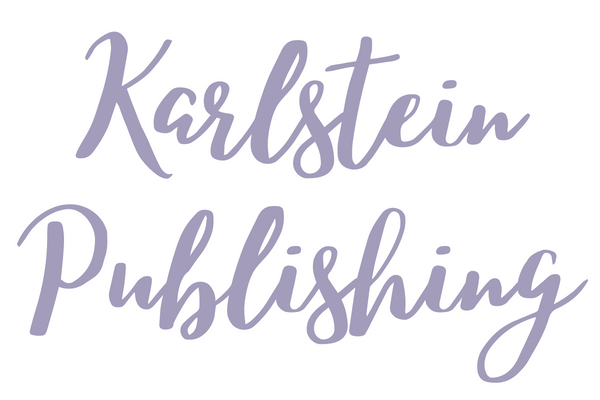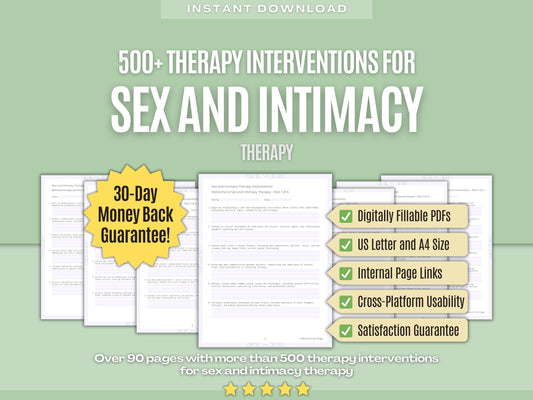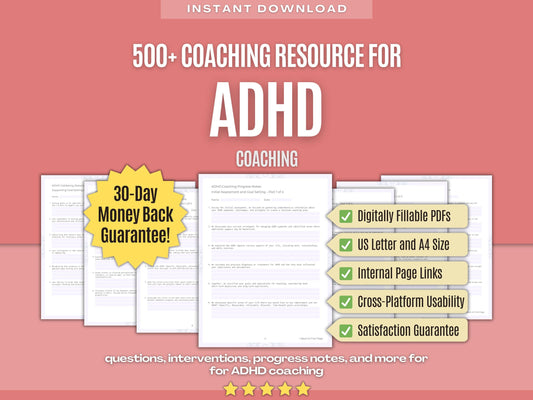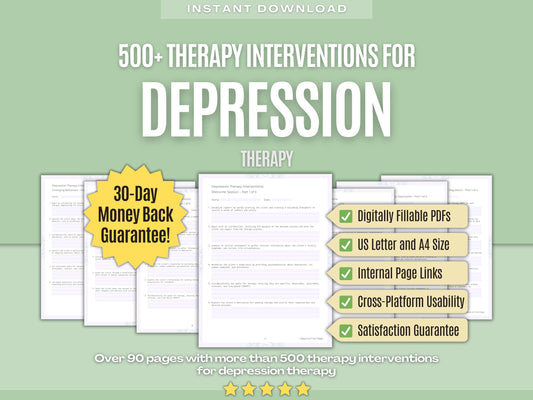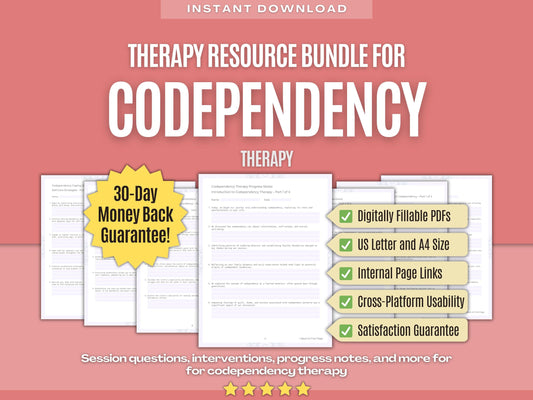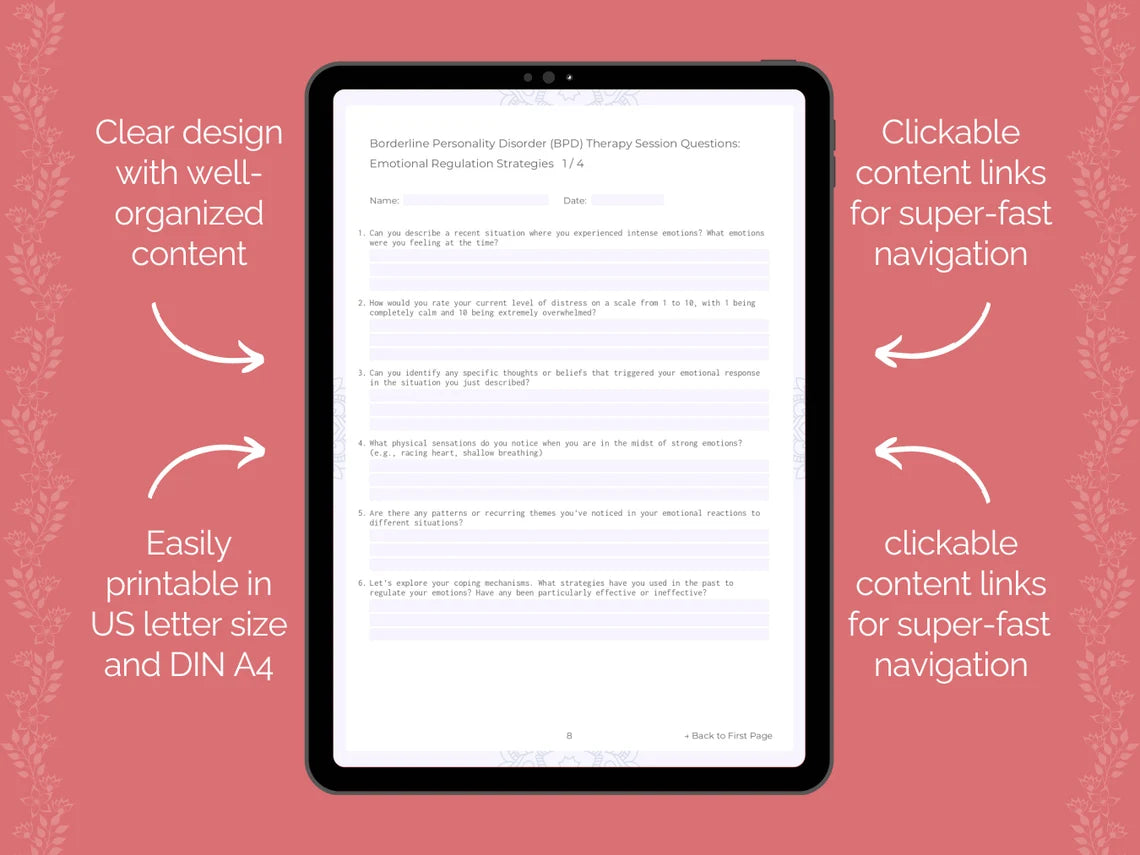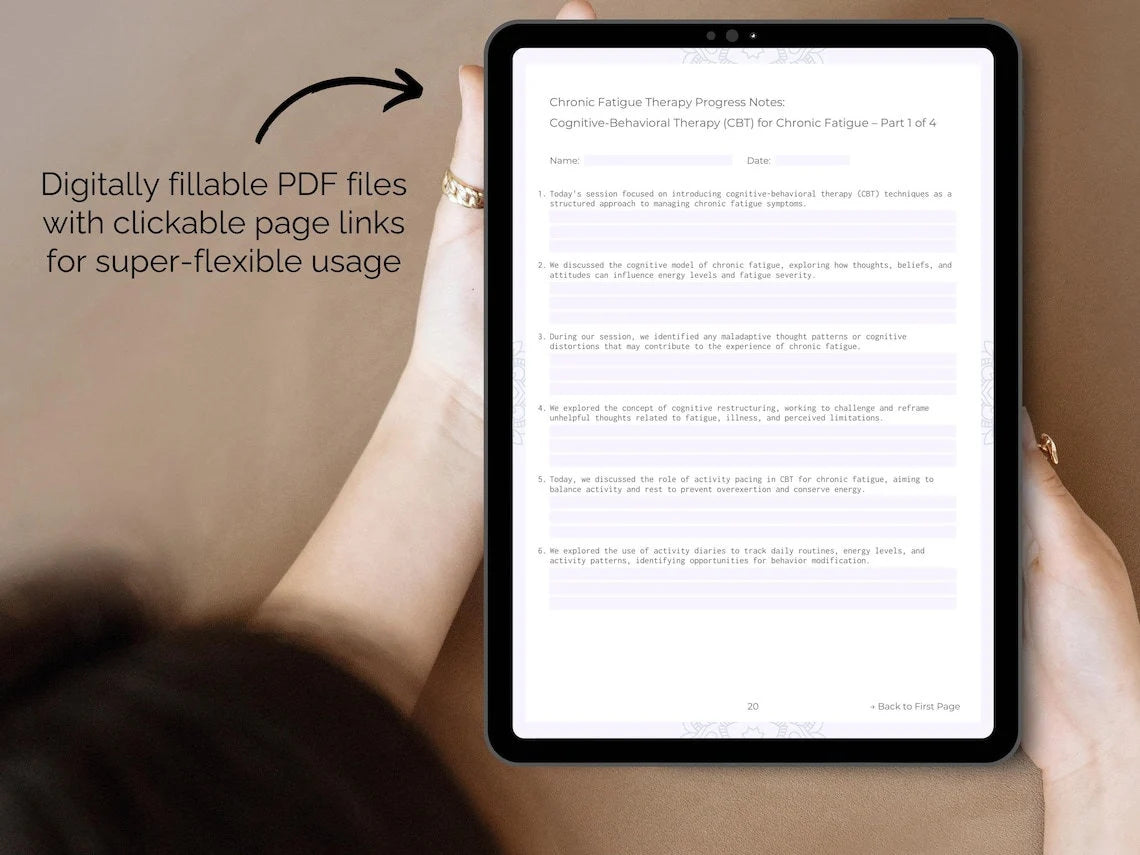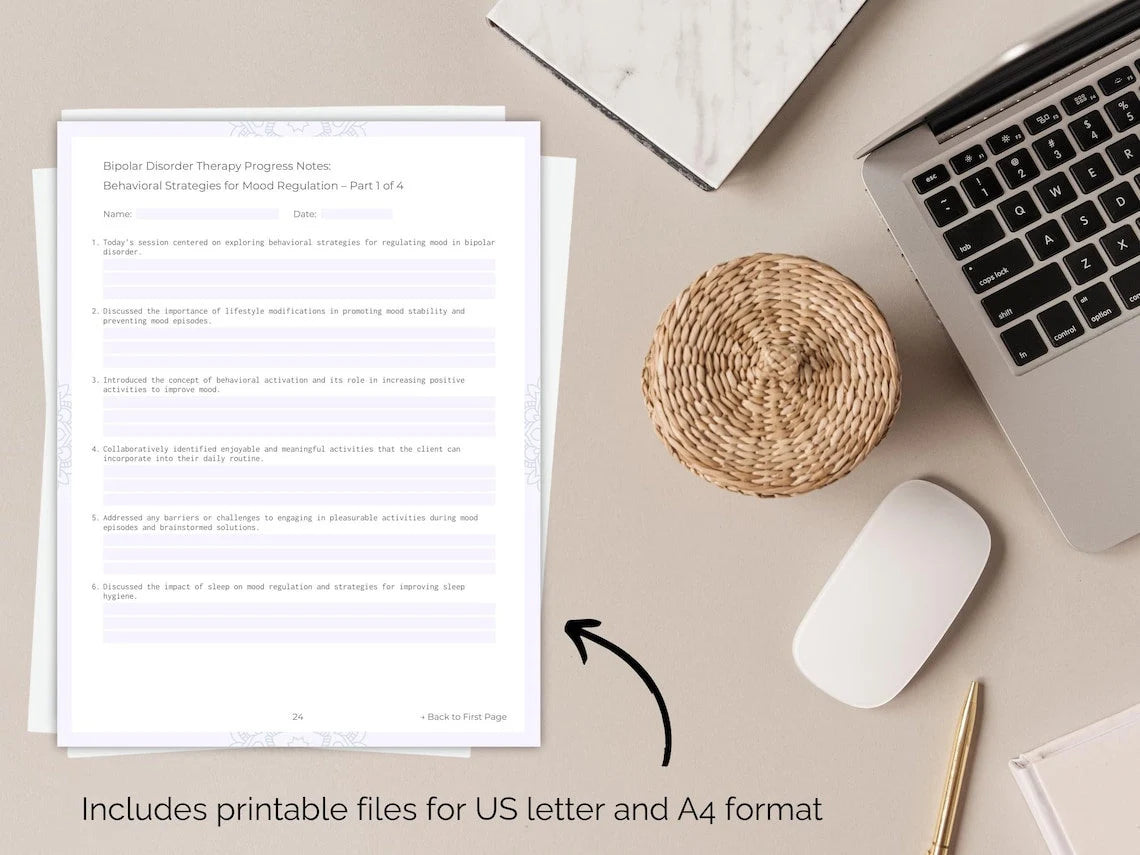Elevate Your Therapy and Guide Your Clients to Inner Healing with Our Bipolar Disorder Therapy Interventions! ✨
1. Beginning Bipolar Therapy
- Begin by establishing a strong therapeutic alliance, emphasizing empathy, respect, and collaboration to create a safe space for the client to explore their experiences with bipolar disorder.
- Explore the client's understanding of bipolar disorder, addressing any misconceptions or concerns they may have about the diagnosis.
- Collaboratively develop a treatment plan that addresses the client's unique needs and goals, incorporating medication management, psychotherapy, and lifestyle interventions.
- Explore the impact of bipolar disorder on the client's daily functioning, including relationships, work, school, and self-care activities.
- Teach the client coping strategies for managing mood fluctuations, including mindfulness techniques, relaxation exercises, and stress reduction strategies.
- Explore the client's social support system and encourage them to involve supportive friends, family members, or support groups in their treatment.
- Introduce the concept of mood monitoring and encourage the client to track their mood, energy levels, and sleep patterns on a regular basis.
- Validate the client's emotions and experiences, acknowledging the challenges of living with bipolar disorder while also fostering hope and resilience.
- Introduce cognitive-behavioral techniques, such as cognitive restructuring and behavioral activation, for managing mood symptoms and challenging negative thought patterns.
- Discuss the potential impact of substance use on bipolar symptoms and provide support and resources for addressing any substance abuse issues.
- Explore the client's spirituality or religious beliefs and discuss how these may impact their coping strategies and treatment preferences.
Need more? Find all 500+ Therapy Interventions for Bipolar Disorder Therapy in our Digital Workbook!
2. Bipolar Disorder Education
- Begin by providing a comprehensive overview of bipolar disorder, including its diagnostic criteria, prevalence, and common symptoms.
- Explain the cyclical nature of bipolar disorder, highlighting the alternating periods of mood elevation (mania or hypomania) and depression that characterize the illness.
- Explore the neurobiological basis of bipolar disorder, explaining how abnormalities in brain structure and function contribute to mood dysregulation.
- Address common myths and misconceptions about bipolar disorder, such as the belief that mood swings are simply a result of personality flaws or weakness.
- Explore the potential consequences of untreated bipolar disorder, such as increased risk of suicide, substance abuse, and financial or legal problems.
- Discuss the role of medication in treating bipolar disorder, including mood stabilizers, antidepressants, antipsychotics, and other psychotropic medications.
- Introduce the concept of psychotherapy as an adjunctive treatment for bipolar disorder, discussing the different approaches such as cognitive-behavioral therapy, interpersonal and social rhythm therapy, and family-focused therapy.
- Explore the potential challenges of living with bipolar disorder, such as stigma, relationship difficulties, and managing work or academic responsibilities.
- Address the importance of self-care in managing bipolar disorder, including engaging in enjoyable activities, practicing relaxation techniques, and prioritizing physical health.
- Encourage clients to track their mood symptoms using mood charts or smartphone apps, and discuss how this can help them identify patterns and early warning signs of mood episodes.
- Discuss the importance of setting realistic goals and expectations for treatment, emphasizing the gradual nature of recovery and the need for patience and perseverance.
Need more? Find all 500+ Therapy Interventions for Bipolar Disorder Therapy in our Digital Workbook!
3. Mindfulness for Bipolar Stability
- Begin by introducing the concept of mindfulness as a tool for promoting stability and well-being in individuals with bipolar disorder.
- Explore the potential benefits of mindfulness for bipolar disorder, including improved emotion regulation, reduced stress reactivity, and enhanced coping skills.
- Guide clients in incorporating mindfulness into their daily routine, suggesting specific times and contexts for practicing mindfulness exercises, such as upon waking up or before meals.
- Explore the relationship between mindfulness and self-compassion, emphasizing the importance of treating oneself with kindness and acceptance, especially during difficult times.
- Introduce the concept of mindfulness-based cognitive therapy (MBCT) for bipolar disorder, which combines mindfulness practices with cognitive-behavioral techniques to prevent relapse and promote stability.
- Explore the impact of mindfulness on sleep quality and circadian rhythms, suggesting mindfulness practices as a tool for promoting relaxation and improving sleep hygiene.
- Discuss the benefits of incorporating mindfulness into other aspects of treatment, such as medication management, psychotherapy, and lifestyle interventions.
- Address any questions or concerns that clients may have about mindfulness, providing reassurance and clarification as needed.
- Explore the concept of "beginner's mind," encouraging clients to approach mindfulness practice with openness, curiosity, and a willingness to learn from each moment.
- Teach clients mindfulness-based coping strategies for managing cravings and urges related to substance use or other impulsive behaviors often associated with bipolar disorder.
- Address the potential role of mindfulness in reducing symptoms of comorbid conditions such as anxiety disorders or attention-deficit/hyperactivity disorder (ADHD), which often co-occur with bipolar disorder.
Need more? Find all 500+ Therapy Interventions for Bipolar Disorder Therapy in our Digital Workbook!
4. Dialectical Behavior Therapy (DBT) for Emotional Balance
- Begin by introducing the principles of dialectical behavior therapy (DBT) as a comprehensive treatment approach for promoting emotional balance and coping skills in individuals with bipolar disorder.
- Conduct a thorough assessment of the client's emotional regulation skills and identify areas of difficulty or dysfunction, such as difficulty tolerating distress, impulsivity, or interpersonal conflict.
- Explore the concept of radical acceptance, encouraging clients to acknowledge and embrace difficult emotions or situations without judgment or resistance, fostering a sense of inner peace and resilience.
- Teach clients interpersonal effectiveness skills for navigating challenging social interactions and conflicts, helping them to communicate assertively, set boundaries, and maintain relationships.
- Explore the connection between thoughts, emotions, and behaviors, helping clients to identify and challenge cognitive distortions or "thinking traps" that contribute to mood instability.
- Discuss the importance of self-care in promoting emotional well-being, encouraging clients to prioritize activities that nourish their mind, body, and spirit, such as exercise, relaxation, and hobbies.
- Explore the concept of dialectics, helping clients to recognize and reconcile opposing truths or perspectives in their lives, fostering a sense of balance and acceptance.
- Address any challenges with mindfulness practice, such as resistance, impatience, or skepticism, and work with clients to develop strategies for overcoming these obstacles.
- Explore the impact of validation on emotional well-being, helping clients to recognize and validate their own emotions and experiences, as well as those of others.
- Address any fears or doubts that clients may have about change or recovery, providing reassurance and encouragement for the journey toward emotional wellness.
- Provide resources for further exploration of DBT, including books, workbooks, websites, and DBT-trained therapists or groups in the community.
Need more? Find all 500+ Therapy Interventions for Bipolar Disorder Therapy in our Digital Workbook!
5. Interpersonal Therapy (IPT) for Relationship Management
- Begin by exploring the client's current relationships, identifying strengths and areas for improvement.
- Facilitate discussions on communication skills, emphasizing active listening and assertive expression.
- Identify any problematic interpersonal dynamics and work on developing healthier alternatives.
- Explore the impact of bipolar symptoms on relationships and develop coping strategies together.
- Explore past relationship experiences to identify recurring patterns and potential triggers.
- Help the client identify and challenge negative beliefs about themselves and their relationships.
- Teach relaxation techniques to manage stress and anxiety within interpersonal interactions.
- Explore the role of social support networks and encourage the client to strengthen these connections.
- Explore family dynamics and their impact on current relationships.
- Teach problem-solving skills to address relationship challenges effectively.
- Address any feelings of loneliness or isolation and work on strategies to foster connection.
Need more? Find all 500+ Therapy Interventions for Bipolar Disorder Therapy in our Digital Workbook!
6. Emotion-Focused Therapy (EFT) for Mood Understanding
- Begin by exploring the client's emotional experiences related to bipolar disorder, inviting them to reflect on the range and intensity of their mood states.
- Utilize emotion-focused techniques to help the client identify and label their emotions accurately, increasing emotional awareness and literacy.
- Encourage the client to express their emotions openly and without judgment, creating a safe space for emotional exploration and expression.
- Explore the function and purpose of the client's emotions within the context of their life and relationships, helping them understand the adaptive significance of their emotional experiences.
- Utilize emotion-focused experiential techniques, such as chair work or role-playing, to help the client process and work through intense emotions in a safe and supportive environment.
- Encourage the client to practice emotion-focused coping strategies, such as emotional expression, regulation, and acceptance, to manage mood fluctuations effectively.
- Explore the impact of early life experiences and attachment patterns on the client's emotional regulation and mood stability.
- Utilize emotion-focused interventions to help the client identify and challenge maladaptive beliefs and coping strategies related to their emotions and bipolar disorder.
- Encourage the client to identify and engage in activities that promote emotional well-being and regulation, such as hobbies, exercise, or socializing.
- Explore the client's interpersonal relationships and how they may impact their emotional experiences and mood stability.
- Utilize emotion-focused interventions to help the client develop a greater sense of emotional resilience and flexibility in coping with bipolar disorder.
Need more? Find all 500+ Therapy Interventions for Bipolar Disorder Therapy in our Digital Workbook!
7. Psychodynamic Insights for Bipolar Dynamics
- Begin by establishing a trusting therapeutic relationship, providing a safe space for the client to explore their thoughts, feelings, and experiences related to bipolar disorder.
- Encourage the client to explore unconscious conflicts and desires that may manifest in their mood fluctuations and symptoms of bipolar disorder.
- Explore the client's early childhood experiences of attachment, loss, or trauma that may influence their patterns of mood regulation and interpersonal relationships.
- Utilize exploration of the client's internalized object relations to help them understand how they internalize and reenact early relational dynamics in their current relationships.
- Utilize exploration of the client's sense of identity and self-concept to help them understand how these aspects of their psyche may be influenced by their experiences with bipolar disorder.
- Encourage the client to explore their unconscious guilt or shame, helping them understand and process these feelings in relation to their experiences of bipolar disorder.
- Encourage the client to explore their fantasies of omnipotence or powerlessness, examining how these fantasies may influence their experience of bipolar disorder.
- Encourage the client to explore their fantasies of escape or self-destruction, examining how these fantasies may serve as unconscious coping mechanisms for managing their bipolar symptoms.
- Encourage the client to explore their unconscious desires for love, acceptance, and validation, helping them understand how these desires may manifest in their experience of bipolar disorder.
- Encourage the client to explore their fantasies of loss or abandonment, helping them understand how these fantasies may contribute to their mood fluctuations and symptom severity.
- Encourage the client to explore their unconscious conflicts related to autonomy and dependence, helping them gain insight into how these conflicts may influence their mood regulation and interpersonal relationships.
Need more? Find all 500+ Therapy Interventions for Bipolar Disorder Therapy in our Digital Workbook!
8. Music Therapy for Emotional Regulation
- Begin by introducing the concept of music therapy as a tool for emotional regulation in individuals with bipolar disorder, emphasizing the therapeutic potential of music in managing mood fluctuations.
- Utilize active listening techniques to help the client engage with the music on a deeper level, encouraging them to notice and reflect on the emotional resonance of different songs.
- Utilize music-assisted relaxation techniques, such as guided imagery or progressive muscle relaxation, to help the client achieve a state of deep relaxation and calm.
- Encourage the client to engage in active music-making activities, such as singing, playing an instrument, or improvising, as a means of expressing and regulating their emotions.
- Encourage the client to create mood playlists for different times of day or different emotional states, providing them with a toolkit of music to support their emotional regulation throughout the day.
- Explore the client's emotional triggers and patterns in relation to their bipolar disorder, using music as a tool for insight and self-awareness.
- Utilize guided music listening exercises to help the client explore and process difficult emotions, providing a structured framework for emotional expression and release.
- Utilize group music therapy sessions to provide social support and connection for individuals with bipolar disorder, fostering a sense of community and belonging through shared musical experiences.
- Encourage the client to engage in music-based movement activities, such as dance or guided movement exercises, to help them release tension and express emotions nonverbally.
- Encourage the client to engage in active music listening as a form of self-care and self-soothing, providing them with a resource for managing stress and emotional dysregulation in their daily life.
- Encourage the client to engage in music-based journaling or reflection exercises, using music as a prompt for writing or drawing about their emotional experiences.
Need more? Find all 500+ Therapy Interventions for Bipolar Disorder Therapy in our Digital Workbook!
9. Concluding Therapy for Bipolar Disorder
- Reflect on the client's progress throughout the therapy journey, acknowledging the challenges they have overcome and the growth they have experienced.
- Explore any remaining goals or concerns the client may have, ensuring that all relevant issues have been addressed before concluding therapy.
- Validate the client's experiences and emotions, acknowledging the impact of bipolar disorder on their life and recognizing the courage it takes to seek help and engage in therapy.
- Explore any potential triggers or stressors that may arise in the future, discussing how the client can continue to use the skills learned in therapy to navigate these challenges.
- Discuss the importance of self-care and wellness practices in maintaining mental health, emphasizing the role of lifestyle factors such as sleep, diet, exercise, and stress management.
- Collaborate with the client to develop a relapse prevention plan, outlining specific steps and strategies for managing symptoms and preventing relapse in the future.
- Explore the client's feelings about ending therapy, validating any mixed emotions they may have and addressing any concerns or fears about transitioning out of therapy.
- Encourage the client to reflect on their personal growth and insights gained from therapy, discussing how these insights can inform their continued journey towards wellness.
- Offer validation and support for any feelings of sadness or loss the client may experience as therapy comes to an end, recognizing the significance of the therapeutic relationship.
- Normalize the idea of seeking support in the future if needed, reassuring the client that it is okay to reach out for help when facing challenges related to bipolar disorder.
- Provide a summary of the key insights and learnings from therapy, ensuring that the client leaves with a clear understanding of the progress made and the tools acquired.
Need more? Find all 500+ Therapy Interventions for Bipolar Disorder Therapy in our Digital Workbook!
10. Final Session Reflections
- Begin by inviting the client to reflect on their overall therapy journey, encouraging them to share their thoughts, feelings, and insights about the process.
- Discuss the goals the client set at the beginning of therapy, reviewing how these goals have evolved over time and discussing which goals have been achieved.
- Reflect on the therapeutic relationship between the client and therapist, discussing what aspects of the relationship were helpful and supportive for the client.
- Discuss the client's strengths and coping strategies, highlighting the resources they have developed to manage their bipolar disorder effectively.
- Discuss the client's plans for maintaining their progress after therapy concludes, exploring how they will continue to apply the skills and strategies learned in therapy in their daily life.
- Provide validation and support for any feelings of sadness or loss the client may experience as therapy comes to an end, acknowledging the significance of ending a therapeutic relationship.
- Discuss any lingering questions or concerns the client may have about managing their bipolar disorder, providing psychoeducation and guidance as needed.
- Normalize the idea of seeking support in the future if needed, reassuring the client that it is okay to reach out for help when facing challenges related to bipolar disorder.
- Offer encouragement and validation for the client's ongoing commitment to their mental health and well-being, emphasizing their resilience and strength in facing the challenges of bipolar disorder.
- Discuss any referrals or additional resources that may be beneficial for the client moving forward, such as support groups, workshops, or other forms of therapy.
- Encourage the client to celebrate their achievements and successes in therapy, recognizing the hard work and dedication they have put into their healing journey.
We hope that our therapy interventions for Bipolar Disorder therapy will help you to elevate your therapy practice and guide your clients to inner healing! Do you need more therapy interventions for Bipolar Disorder therapy? Find them all in our Digital Workbook! Or do you have any questions or suggestions for us? Please feel free to contact us at any time!
